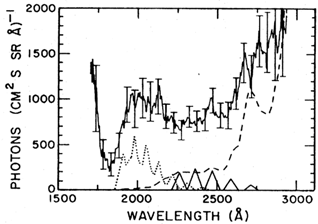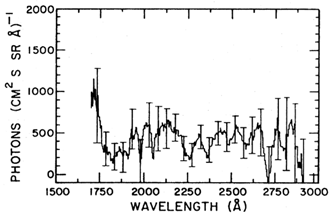Copyright © 1991 by Annual Reviews. All rights reserved
| Annu. Rev. Astron. Astrophys. 1991. 29:
89-127 Copyright © 1991 by Annual Reviews. All rights reserved |
In reviewing the data we consider in this and the next section
the two least controversial spectral regions which are the
wavelengths longward of 2500 Å where the signal is dominated by
zodiacal light and the shortest wavelengths with  < 1216 Å.
< 1216 Å.
The first spectroscopic observation of zodiacal light in the spectral range 1700 to 3200 Å was made by Feldman (23). Early observations are reviewed by Tennyson et al (110). The data of Tennyson et al are themselves of considerable interest and are shown in Figure 10. They were obtained by means of a sounding rocket flight, and the spectra shown were obtained at the highest altitudes (above 257 km).

|
Figure 10. High altitude rocket cosmic
background spectrum (solid line with error bars) of Tennyson et
al (110)
includes zodiacal light (dashed line) and terrestrial
NO airglow emission [NO |
Zodiacal light (easily identifiable from its solar-type
spectrum) is readily apparent in the spectrum of
Figure 10, longward
of 2500 Å. Also apparent, are NO  - and
- and  -band emission detailed in
Figure 6; but use of the
altitude-dependence profiles of Tennyson et
al (108)
allows the extraction of an altitude-independent residual.
Finally, in the spectrum there is a sharp rise at the shortest
wavelengths, which carries a large error bar and which is certainly
spurious - this feature is simply a result of the sharp drop in
experimental system transmission that occurs at the shortest wavelengths.
-band emission detailed in
Figure 6; but use of the
altitude-dependence profiles of Tennyson et
al (108)
allows the extraction of an altitude-independent residual.
Finally, in the spectrum there is a sharp rise at the shortest
wavelengths, which carries a large error bar and which is certainly
spurious - this feature is simply a result of the sharp drop in
experimental system transmission that occurs at the shortest wavelengths.
The match between the ``zodiacal light'' data in Figure 10, and the solar spectrum (dashed line) of Mount & Rottman (79), is not good. But similar data have been obtained in the UVX mission: high-quality UVX zodiacal light spectra which have no NO airglow problem are given by Murthy et al (82), who find excellent agreement with Mount & Rottman (except for the strange ``absorption'' feature at 2700 Å, and emission feature at 2800 Å, that have also been found by earlier workers). The UVX results show that the ultraviolet zodiacal light is much less strongly confined to the ecliptic plane than is the case for the visible zodical light.
In the paper by Tennyson et al (110) we concluded that zodiacal light is not the only source of cosmic diffuse ultraviolet background radiation between 2500 and 3200 Å. Upon removing the zodiacal light and NO contributions from the data of Figure 10, a residuum radiation remained as shown in Figure 11.

|
Figure 11. Cosmic ultraviolet background radiation appears flat, in these units, from 1750 to 2900 Å. The spectrum continues at about the same lebel down to 1216 Å, or thereabouts, and then vanishes. |
This residuum spectrum is approximately flat (the rise at shortest wavelengths in the spectrum of Figure 11 remains spurious) and may be the spectrum of true extra-solar-system diffuse ultraviolet background radiation. Hints of structure in the spectrum are surely spurious: consider, in Figure 10, what has been subtracted. The average intensity is 400 units. Ideas about the origin of this radiation are set out in the next section.